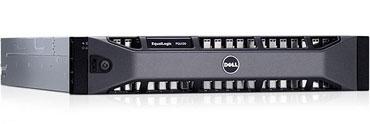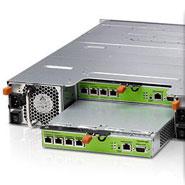Dell's Giant Leap into Tiered Storage

If you're gearing up to pitch Dell's trade-in program to enterprise customers looking to expand their iSCSI storage, you might be interested to know about some significant advances Dell has made recently in its EqualLogic storage systems.
The company in February unveiled the EqualLogic PS6100, a series of 1 GB and 10 GB, 2U or 4U iSCSI arrays, some of which can mix solid-state with spinning hard drives and be configured in multiple storage tiers with automatic data migration.
That's right; Dell now offers the ability to configure multi-tiered storage in a single array. The EqualLogic PS6100XS can accept up to seven 400 GB SSDs plus another 17 600 GB 10K RPM 6 GB/s SAS drives for a total storage capacity of nearly 13 TB, including 2.8 TB of very fast SSD storage. And this all takes place with 2.5-inch drives in a single 2U array. The predecessor to this model housed a maximum of 16 3.5-inch drives in a 3U chassis.
[Related: Chart Topper: Latest Dell PowerEdge A Screamer ]
But the magic really happens in the software. Dell's migration algorithm constantly monitors data movement and performance across all arrays and migrates the most active data where there's the least latency, taking into account disk media, RAID level and other factors, the company said. This array-based intelligence enables the system as a whole to take on greater workloads, and is well suited to spiky workloads typical of VDI and online transaction processing environments.
The 6100 series also now adds more resiliency and fault tolerance with vertical port sharing. "In the event of a cable failure or accidental disconnect, rather than losing the bandwidth because the cable is no longer there, the communications simply switches to the other port and cable," explained Jeff Junker, a technical marketing consultant at Dell.
The feature also can help with network clutter. "A cross point switch inside each controller allows each port to use the corresponding port on the redundant controller as a backup, so you can still get full bandwidth and fail-over with half the cables," Junker said. "This is particularly useful in port constrained environments like remote offices where network ports are maxed or at a premium."
NEXT: Dell EqualLogic PS6100 Performance Results

For testing, Dell sent the CRN Test Center a PS6110, the 10 GB version of the array populated with 24 900-GB 2.5-inch 10k RPM 6 GB/s SAS drives. This unit was equipped with redundant controllers, each with two 10 GB/s interfaces plus management and serial ports. To test its fault tolerance, we simply unplugged a data cable while testing the array's performance. It never missed a beat. As for throughput performance, PS6110 was able to handle as much as IOmeter could throw at it. In other words, our test fixture was unable to reach the unit's maximum performance potential.
Dell also sent CRN a PS6100 4U array fully populated with 24 3.5-inch 3 TB 7200 RPM 6 GB/s SAS drives. By the way, Dell has discontinued use of SATA drives altogether. It will continue to supply replacement drives for all drive types currently in use in the field, but new deliveries will be provisioned only with 6 GB/s SAS drives.
The PS6100 and its 1 GB/s interfaces also performed as expected, maxing out IOmeter and our text fixture with hardly a notice. It too was equipped with redundant controllers, each with four 1 GB/s Ethernet ports plus management and serial ports.
When it updated its firmware to version 5.1 last fall, Dell added the ability to automatically perform load balancing and optimize latency between arrays. According to Junker, Dell implemented this in such a way that it maintains the same capacity balancing but swaps what it calls hot and cold pages. "It's always evaluating and performing active load balancing withing a pool, but if you had SSDs in an array, the hot pages would migrate to those."
Also new in 5.1 is data center bridging, which can allocate segments of available bandwidth for certain applications. "Let's say you're a media company doing live broadcasts," Junker said, for example. "You wouldn't want a production person to be able to grab full bandwidth when rendering a video and put your live broadcast off the air." The technology would permit, a percentage of the pipe to a particular class of application. DCB is intended to interoperate with converged environments such as those incorporating Fibre Channel and Ethernet. It works only in Dell's 10 GB/s arrays and requires DCB-aware switches and NICs on all ends.
Dell's EqualLogic PS6100 arrays start at around $10,000, and they're recommended by the CRN Test Center.